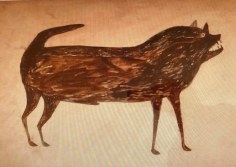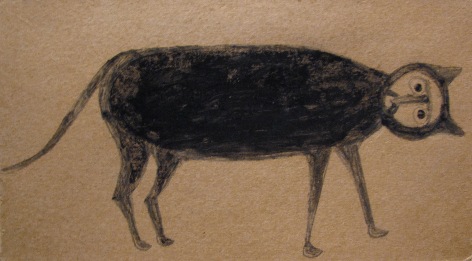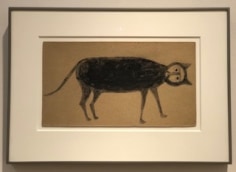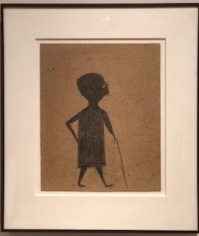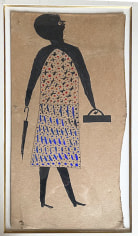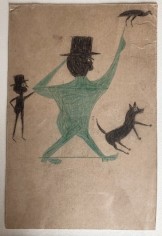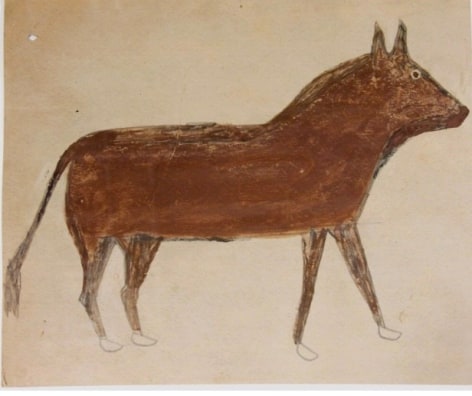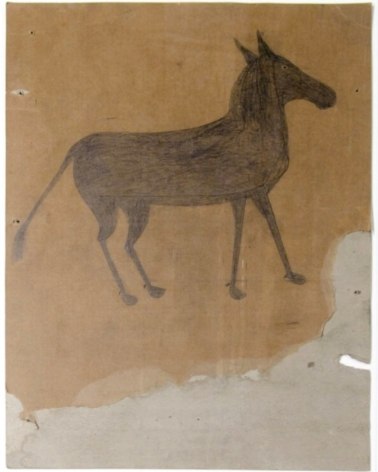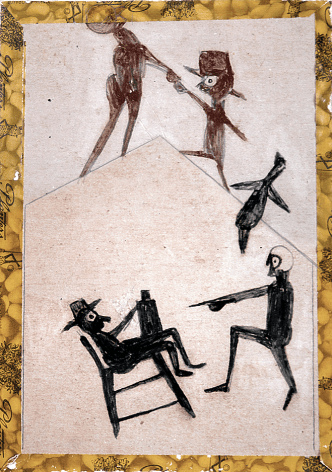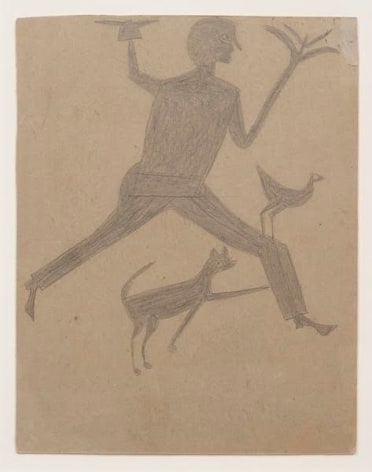
Bill Traylor
Untitled, Man and Woman pointing
18.5 x 16.75 inches
Poster paint and graphite on cardboard
Provenance: Richard Oosterom Collection
SOLD
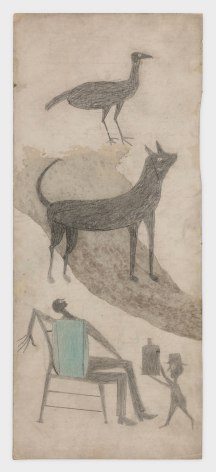
Bill Traylor
Drinking Scene
c. 1939-42
Pencil and colored pencil on found cardboard
19 ¼ x 8 ¼ inches
BT 32
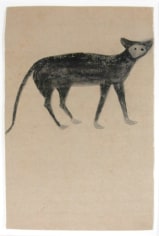
Bill Traylor
Cat, Pale Face
c. 1939-42
Pencil and poster paint on cardboard
13 x 7 1/4 inches
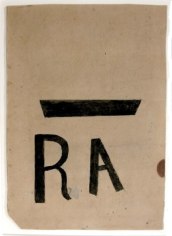
Bill Traylor
RA Poster (Resettlement Administration)
c. 1939-42
Pencil and poster paint on cardboard
12 x 8 inches
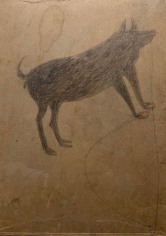
Bill Traylor
Sow
c. 1939-42
Pencil on cardboard
10 1/4 x 7 1/4 inches
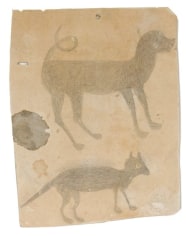
Bill Traylor
Hound Dog and Cat
c. 1939
Pencil on cardboard
10 1/2 x 8 inches
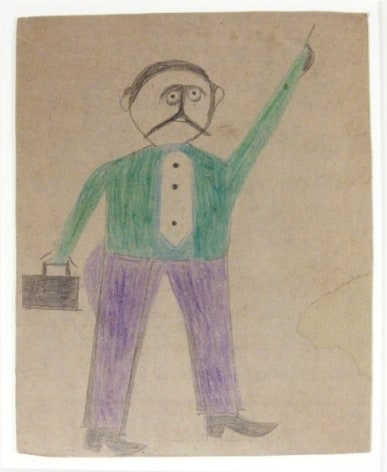
Bill Traylor
Mexican Man ("He Just Come to Town")
c. 1939-42
Pencil and crayon on cardboard
10 3/16 x 7 5/16 inches
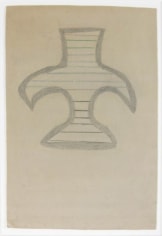
Bill Traylor
Basket Form
c. 1939
Pencil and colored pencil on paper
10 3/4 x 7 1/4 inches
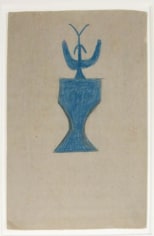
Bill Traylor
Plant in Vase
c. 1939
Pencil and crayon on cardboard
11 1/2 x 7 3/4 inches

Bill Traylor
Chick
c. 1939-42
Pencil on cardboard
8 x 10 1/4 inches
Bill Traylor
Figure 8 Basket
c. 1939
Pencil and crayon on paper
9 15/16 x 7 1/2 inches
Bill Traylor
Cat with Arched Back
c. 1939
Pencil on cardboard
5 3/4 x 8 1/2 inches
Bill Traylor
Untitled, Brown Dog
c. 1939-1943
Pencil and poster paint on found cardboard
14 x 22 inches
BT 192
SOLD
Bill Traylor
Black Cat, with White Face
c. 1939-42
Pencil and poster paint on cardboard
7 7/16 x 13.5 inches
BT 209
Bill Traylor
Old Woman Walking with Cane
c. 1939-42
Pencil on cardboard
11 ¼ x 9 ¼ inches
BT 210
Bill Traylor
Mule On Yellow
c. 1939-42
Pencil on cardboard
8 3/4 x 11 3/4 inches
BT 11
Bill Traylor
Untitled "Woman w handbag and umbrella"
On found cardboard
21 x 10 1/4 inches
BT 215
SOLD
Bill Traylor
Untitled "Man with hat in a green suit, pointing at a bird"
On found cardboard
11 3/4 x 7 3/4 inches
BT 216
Bill Traylor
Young Brown Steer
c. 1939-42
Pencil and poster paint on cardboard
11 x 13 1/2 inches
BT 133 – BT 212
SOLD
Bill Traylor
The Startled Young Mule
c. 1939-42
Pencil on cardboard
19 ¾ x 14 inches
BT 213
SOLD
Bill Traylor
Small Brown Buzzard
c. 1939-42
Pencil and poster paint on cardboard
10 ½ x 6 3/4 inches
BT 214
SOLD
Bill Traylor
Untitled, Drinking Bout
1938-1943
10 x 7 inches
Pencil, colored pencil, watercolor on found cardboard
SOLD
Bill Traylor
Untitled, Woman Pointing
1938-1943
14 x 11 inches
Pencil, colored pencil, watercolor on found cardboard
SOLD
Bill Traylor
Untitled, Goat
c. 1938 – 1942
Mixed media on cardboard
10.5 x 14 inches
BT 206
SOLD
Bill Traylor
Construction: Man with Bird and Hatchet
Graphite, colored pencil on cardboard
14.5 x 13 inches
BT 204
SOLD
Bill Traylor
Red Snake / Blue Man
(Double-sided) Side A
c. 1939-42
Colored pencil on cardboard
10.75 x 4.75 inches
18.5 x 12.5 inches framed
BT 199
SOLD
Bill Traylor
Red Snake / Blue Man
(Double-sided) Side B
c. 1939-42
Colored pencil on cardboard
10.75 x 4.75 inches
18.5 x 12.5 inches framed
BT 199
SOLD
Bill Traylor
Spiritual Blue Goat
c. 1939-42
Poster paint on cardboard
9 x 12 inches
16.25 x 20.25 inches framed
BT 201
SOLD
Bill Traylor
Red Man with Pipe
Graphite, colored pencil on cardboard
9.75 x 8 inches
BT 203
SOLD
Bill Traylor
Untitled, Red / Orange Dog
Graphite and tempera on found cardboard
12 x 12.5 inches
BT 205
SOLD
Bill Traylor
Untitled, Blue and Brown House with Chimneys
Graphite and tempera on found cardboard
14.5 x 13 inches
BT 202
SOLD
Bill Traylor
Blacksmith Shop
c. 1938-1942
Graphite on cardboard
12.5 x 5.75 inches
BT 195
SOLD
Bill Traylor
Big Spotted Snake
c. 1938-1942
Poster paint, graphite on cardboard
15 x 25.25 inches
BT 197
SOLD
Bill Traylor
Man Spouting hand with Dog and Bird
c. 1938-1942
Graphite on cardboard
11.25 x 8.75 inches
BT 196
Bill Traylor
Woman with Red Bracelet
c. 1938-1942
Tempera on cardboard
13.5 x 7 inches
BT 198
SOLD
Untitled
Black male dog with red eye and tongue
c. 1939-1942
Pencil, poster paint on found cardboard
16.5 x 16 inches (image)
BT 184
SOLD
Untitled
Black spotted male dog
c. 1939-1942
Pencil, poster paint on found cardboard
14 x 14.5 inches (image)
BT 185
SOLD
Untitled Man with top hat and satchel
Pencil, poster paint on found cardboard
15 1/2 x 12 inches
c. 1940
Exhibited: Kunstmuseum, Bern 1999
Robert Hall Fleming Museum, U. of Vermont, 1999
Illustrated: Exhibition Catalog Deep Blues, Bill Traylor, 1854-1949, p. 80
SOLD
Untitled Spotted Cat
Pencil and poster paint on found cardboard
13 x 11 inches
1939-43
SOLD
Exhibited:
Black Folk Art In America: 1933-1983 Corcoran Gallery (Smithsonian Institution), 1982
Speed Museum of Art, Louisville, KY
Brooklyn Museum, Brooklyn, NY
Craft Folk Art Museum, Los Angeles, CA
The Institute for the Arts, Rice University, Houston, TX
The Field Museum, Chicago, IL, Illustrated in Exhibition Catalog, p.145
Untitled Peg-Legged Man
Pencil and poster paint on found cardboard
11 1/2 x 8 inches
1939-43
Illustrated:
Bill Traylor: High-singing Blue catalog from Hirschl and Adler Gallery, NYC and Carl Hammer Gallery , Chicago exhibitions. 1997
SOLD
Untitled Man in "High-singing blue" with bag and umbrella
Pencil and poster paint on found cardboard
17 x 13 inches
1939-1943
SOLD
Untitled, Three Figure Construction in Black
14 x 14. 5 inches
Pencil, poster paint on found cardboard
BT190
c. 1939-42
SOLD
Untitled Man Pointing
Pencil and poster paint on found cardboard
17 1/4 x 11 1/4 inches
c. 1939-43
SOLD
Untitled, Horse
Signed
9/9/39
Pencil on cardboard
19 3/4 x 14 inches
BT 159
SOLD
William "Bill" Traylor (1853–1949) was an African-American self-taught artist from Lowndes County, Alabama. Born into slavery, Traylor spent the majority of his life after emancipation as a sharecropper. It was only after 1939, following his move to Montgomery, Alabama that Traylor began to draw. At the age of 85, he took up a pencil and a scrap of cardboard to document his recollections and observations. From 1939 to 1942, while working on the sidewalks of Montgomery, Traylor produced nearly 1,500 pieces of art.
While Traylor received his first public exhibition in 1940, it wasn’t until the late 1970s, thirty years after his death, that his work finally began to receive broader attention. Recent acceptance of Traylor as a significant figure of American folk and modern art has been founded both on the efforts of Charles Shannon, as well as the evolving tastes of the art world. Shannon, who first encountered Traylor’s work in 1940, brought Traylor to the attention of the larger art world. Since then, public and scholarly perception of Bill Traylor’s life and work has been in constant evolution. First held up as an example of "primitive" or "outsider" art, Traylor now holds a central position in the fields of "self-taught" and modern art.
Life
Bill Traylor was born in April 1853, in Benton, Alabama. His parents, Sally (1815–1880) and Bill Calloway (1805–1860+) were slaves on the plantation of George Hartwell Traylor (1801–1881), a white cotton grower. He had five brothers and sisters, Liza (1837), Henry (1845), Frank (1846), Jim (1847), and Emet (1854).
For young Traylor, the mid-1860s marked a period of radical personal and economic change. In 1865, Traylor witnessed the Confederacy’s loss to the Union. This social and political rupture was compounded by the death of his father sometime between 1860 and 1866. While the end of the war ensured his legal emancipation, Traylor remained entrapped in the economic structures of the South's Jim Crow laws. He continued to work on the plantation, but now as a sharecropper.
While documenting the details of Traylor’s early life remains difficult, scholars have noted that Traylor fathered a number of children over his lifetime. In 1884, Traylor started a family with Larisa Dunklin (1872-). By 1887, they had had three children: George, Pauline, and Sally. By 1898, the couple had five more children: Rueben, Easter, Alice, Lillian, and an unnamed "child". In 1887, Traylor fathered Nettie from another relationship. Additionally, in the late 1890s, Traylor took a second wife, Laura Williams (1870-). The couple had five children: Clement, Will, Mack, John Henry, and Walter. In 1902, he had a son named Jimmie, with another woman. Later in life, Traylor was quoted as mentioning that "he raised twenty-odd children."
In 1909 Traylor was farming in Montgomery County and in 1928 Traylor left for the capital city of Montgomery. Explaining his moves,Traylor later remarked: "My white folks had died and my children had scattered." For 75-year-old Traylor, it would prove to be a challenging new beginning, but he rented a room and later a small shack and found work to support himself. Several years after the move, he found himself struggling to make ends meet. After rheumatism prevented him from continuing to work at a shoe factory, Traylor was forced out on to the streets. Receiving a small public assistance stipend, he entered into the ranks of the homeless. At night he slept the backroom of the Ross-Clayton Funeral Home. During the day, he camped out on Monroe Avenue. It was there, at the center of Montgomery’s African American community, that Traylor began his artistic career.
In June 1939, Charles Shannon, a young, white artist, first noticed Traylor and his budding talent. Intrigued, Shannon began to repeatedly stop by Traylor’s block to observe him working. Shannon later remarked on the progression of Traylor’s craft. "He worked steadily in the days that followed and it rapidly became evident that something remarkable was happening: his subjects became more complex, his shapes stronger, and the inner rhythm of his work to began assert itself."
Soon after this encounter Shannon began to supply Traylor with poster paints, brushes, and drawing paper. A friendship soon transpired. In February 1940, New South, a cultural center that Shannon founded, launched the exhibit, "Bill Traylor: People’s Artist." It included a hundred of Traylor’s drawings. Nevertheless, despite numerous reviews in local newspapers, none of Traylor’s works were sold. The exhibit, however, remains notable. It was the only one that Traylor would live to see.
In 1942, Traylor made his New York debut. From January 5 to January 19, the Ethical Culture Fieldston School in Riverdale, New York hosted "Bill Traylor: American Primitive (Work of an old Negro)". Victor E. D’Amico, The Museum of Modern Art’s then director of education, organized the exhibit. Nevertheless, while the exhibit introduced Traylor’s work to the larger New York art community, it did not result in the purchase of any Traylor pieces by any museum. Notably, Alfred Barr, the director of MoMA, offered to purchase several drawings for the museum’s collection, as well as his own personal one. However, after he only offered one or two dollars for each Traylor’s piece, the deal quickly fell through.
From 1942 to 1945, Traylor lived with his children and other relatives in Detroit, Chicago, New York, Philadelphia, and Washington D.C. After losing his leg to gangrene, Traylor moved back to Montgomery to live with his daughter, Sarah (Sally) Traylor Howard. On October 23, 1949, he died at Oak Street Hospital in Montgomery. He was later buried at Mount Moriah Cemetery.


